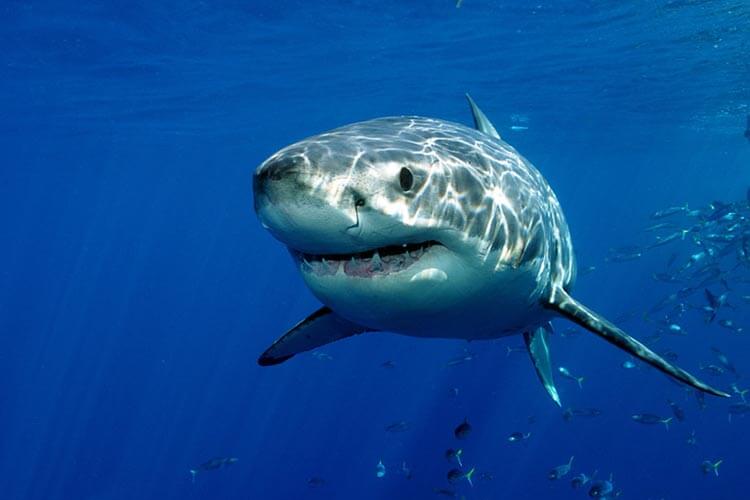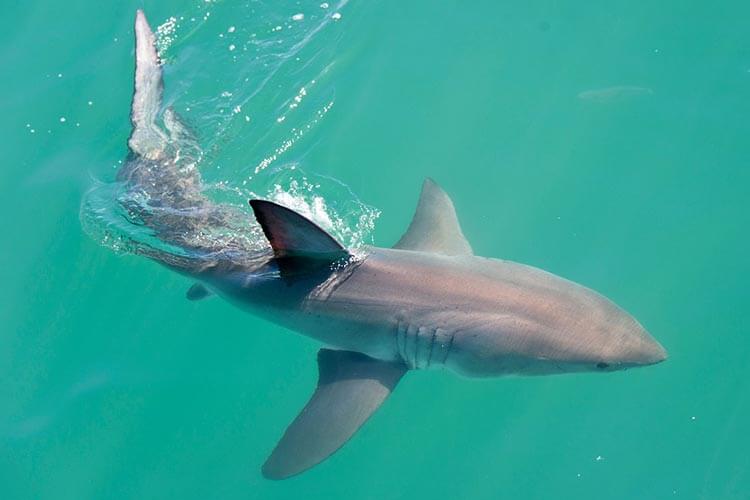
Scientists say that a spatial shift in the great white shark’s range caused by warming oceans poses a threat to the endangered species
By DIVE Staff
Warming ocean temperatures caused by climate change are driving great white sharks further north than usual, according to a recent study by scientists from Monterey Bay Aquarium, published in the online journal Scientific Reports.
The research was sparked by a surge in the sightings of juvenile great whites (Carcharodon carcharias) around Monterey Bay, located in central California, during a marine heatwave which struck the north Pacific region between 2014 and 2016. Previously, the juvenile sharks were thought to be confined to a nursery located in the warmer waters of the southern California Current.
The study found that, on average, the range of the juvenile great whites extended from 34°N, as recorded from 1982 to 2013, to 38.5°N following the heatwave, an increase of approximately 310 miles northwards. According to the report, ‘[the] spatial shift is significant as it creates potential conflicts with commercial fisheries, protected species conservation, and public safety concerns.’
In addition, the report also found that the area of ‘thermally suitable habitat for juvenile sharks’ was reduced by an average of 223.2 sq km between 1982 and 2019, with the lowest extent of the sharks’ range coming in 2015, during the peak of the marine heatwave.
Related articles

Great white sharks are endothermic poikilotherms, meaning they are able to greatly vary their internal body temperatures in response to their surroundings. In adult sharks, the low surface area to volume ratio of their cylindrical bodies means they can withstand the much lower temperatures of their hunting grounds, where they prey on blubber-rich seals as a major part of their diets.
Juvenile sharks, however, have a greater surface to volume ratio than adults, which makes them less able to deal with cooler water temperatures and therefore limits their range. Juvenile great whites remain in warmer waters and mostly consume fish before changing their ranges and diets once they are of a size to hunt the much larger and more powerful seals.
The data used to prepare the report were collected from a wide range of sources. Dedicated field observations were combined with historical sightings from recreational shark-watching trips and a community-based science project, where members of the public submit geo-tagged shark images to a database of sightings via the iNaturalist website and app. Temperature readings from 14 tagged animals found that, while the water temperature to which the sharks were exposed varied between 6-26°C, they much preferred to remain in a very specific temperature band of between 16 and 20°C.
Changes in the sharks’ historical range are already thought to be having an impact on other endangered species. Although they are not part of the great white’s diet, an increasing number of sea otters carcasses have been found with great white bite marks, a finding in line with the change in the distribution of the sharks across the warming water.

‘As the Southern sea otter population today is distributed from 34 to 37°N,’ states the report, ‘sea otters have not substantially overlapped with juvenile white sharks for a century or longer. However, the extensive record of sea otter strandings with shark bite wounds today represents the single greatest mortality source facing the threatened species.’
The risk is further exacerbated with the loss of extensive kelp beds in the area which would have previously provided shelter to the otters, and thus make them more susceptible to attacks by the great whites.
‘After studying juvenile white shark behaviour and movements in southern California for the last 16 years, it is very interesting to see this northerly shift in nursery habitat use,’ said Dr Chris Lowe, director of the California State University’s Shark Lab. ‘I think this is what many biologists have expected to see as the result of climate change and rising ocean temperatures. Frankly, I’ll be surprised if we don’t see this northerly shift across more species.’
‘Nature has many ways to tell us the status quo is being disrupted, but it’s up to us to listen,’ Dr Kyle Van Houtan, one of the report’s contributing authors and Chief Scientist at Monterey Bay Aquarium. ‘These sharks – by venturing into territory where they have not historically been found – are telling us how the ocean is being affected by climate change.’
The full report by Tanaka, K.R., Van Houtan, K.S., Mailander, E. et al. ‘North Pacific warming shifts the juvenile range of a marine apex predator.’ Sci Rep 11, 3373 (2021), can be found at www.doi.org/10.1038/s41598-021-82424-9


